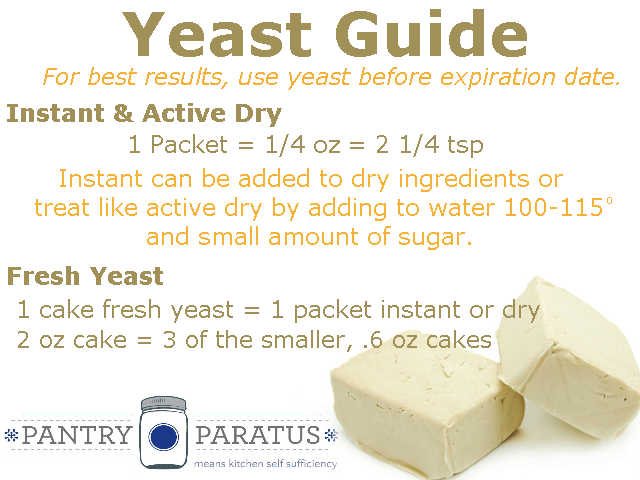Active Dry Yeast Packet Conversion
Yeast & Baking Lessons - Yeast Types & Usage - Active Dry Yeast. Active Dry Yeast is the original all- natural yeast that has been used by generations of bread bakers. Active Dry Yeast provides ultimate baking activity in all yeast doughs, from low sugar to highly sweetened breads. Active Dry Products include RED STAR. Any thermometer will work as long as it measures temperatures between 7.
Active Yeast vs. Instant Yeast. I must confess that I find this a bit confusing..

More About Active Dry Yeast. This is probably what comes to mind when you think of yeast. It's a type of dry yeast that's granular, with a consistency similar to. All I have is active dry yeast. How will this change the rise.
Preparing Dry Yeast. Dry yeast should be re-hydrated in water before pitching. Often the concentration of sugars in wort is high enough that the yeast can not draw. Yeast & Baking Lessons -Yeast Types & Usage Active Dry Yeast provides ultimate baking activity in all yeast doughs, from low sugar to highly sweetened breads.
And I never liked the fact that, as you knead a dough made with fast- action yeast, you can still see the individual yeast granules in the dough. Do you also do this for salt? I say salt, because as I and many do, we add salt after the autolyse, so we're adding it to the dough. If you use a kosher or a sea salt, the granules are very visible for a few minutes while you knead it or fold it in. I just don't really get how 'seeing' something for a few minutes until it's incorporated makes that ingredient a temporary eyesore. As it boils down to, and as I've said before, neither product is superior in the final product.
You use whatever you use out of preference or convenience, because that's all that seperates the two. As Billybob states, for someone who does not bake daily, the instants (and I include active dry) are too convenient to dismiss. Cost for a product has to be figured by dividing how many items you can produce from that product by the price. If you buy fresh and only make one or two items, that's more expensive per item than someone who bakes often and can make twenty items.
Saf-instant, the first instant dry yeast released to market, is the most widely-sold Lesaffre brand in the world. What's the best way to store yeast? We recommend transferring yeast to an airtight container (glass or acrylic), and storing it in the freezer for up to a year. Yeast Conversion Table. Fresh cake yeast is only sold in a limited number of stores in the Upper Midwest and Northeastern US in that choose to stock it based on. Active dry and instant dry yeast are two common forms of yeast for home use. Although they may look similar, they are mixed into dough using different methods to get.
The instant yeasts can be frozen. It will last at least 1 year beyond its expiration when frozen. I am currently using a bag of SAF Active Dry that expired in Jan of this year (2. Play Guitar For A Living Exeter.
Produced by: Yellow Dog Productions - yellowdogllc.com.
I think I paid less than $6 for that whole bag, and honestly, I have lost count long ago how many items I have made with it, and still have a good solid 6 months left to go. That's cheap, and for the same results. The frozen yeast (and yes, it's Active Dry yeast) can be used straight from the freezer into the dry flour. No need to either bring to room temp or to hydrate/proof it. I take out the bag, pour into my hopper on my scale, and put back in the freezer. Robert Crumb Biography. I dump the hopper into flour and move onto the next recipe step. It's simple and I don't even have to really think about it.
The convenience factor(s) are not preferences, they are very real and factual. Just for fun, here's a breakdown on suggestions and tips for handling fresh yeast, taken from www. None of this is necessary for commercial yeast. It's as easy to store and use as your salt or flour, once we get rid of this persistent wive's tale of needing to hydrate and proof it. And to that end, let me reiterate: When using commercially available yeasts, whether active dry, fast- acting, breadmaker, whatever, there is no need to hydrate and proof it by adding it to a portion of warm water and/or adding a pinch of sugar.
This is a wasted recipe step from an era long gone, and an extra kitchen vessel that no longer needs to be washed. If you do not believe me, I'll go an extra step for proof. Mix up a simple dough.
Combine all ingredients and autolyse for 1. Remove dough from bowl and stretch out on work area. Sprinkle your measured Active Dry or Fast- Acting across your dough. Fold it up a few times, and knead it gently for about 2- 3 minutes. Place back in bowl and autolyse another 2. Proceed to usual kneading or stretch/fold intervals. Round up when finished kneading, and set for bulk fermentation.
Tell me it doesn't rise. Beautifully. No arguing here, just facts, and proof.- Keith.
